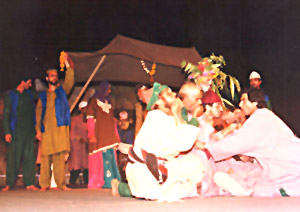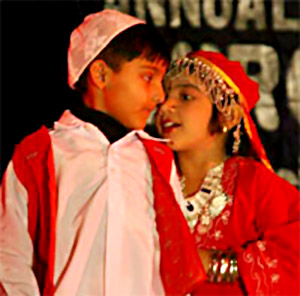 Jammu and Kashmir is primarily famous for its folk theatre and has gained a different color for its regional culture of performing arts. The theatre companies have its own genre of theoretical performance where no clear-cut categories of dance, drama or music. Theatre in Jammu and Kashmir is a sort of total theatre and an amalgam of many media. The Bhand Pather of Kashmir, Achi Lamo and Manepa in Ladakh and the Ras and Bhagat in Jammu region are different forms of theatres in the state having a fine combination of all these form.
Jammu and Kashmir is primarily famous for its folk theatre and has gained a different color for its regional culture of performing arts. The theatre companies have its own genre of theoretical performance where no clear-cut categories of dance, drama or music. Theatre in Jammu and Kashmir is a sort of total theatre and an amalgam of many media. The Bhand Pather of Kashmir, Achi Lamo and Manepa in Ladakh and the Ras and Bhagat in Jammu region are different forms of theatres in the state having a fine combination of all these form.
Bhand Pather is very popular with the common masses, because they have retained its singular patrons to date. Pather, in Kashmiri language means a drama, while Bhand is the performer or actor. The Bhands usually do not have any ready made or pre-decided theme and the performer shows his originality by improving according to the circumstances and the material available. No stage property or green rooms are need for the Bhand Pather art form. The music instruments used in Jashan form of art comprise Surnai, which is a Kashmiri version of the Indian Shehnai, Peshrao, big Dhol and Nagara.
Achi Lamo is a performance usually depicting some Buddhist Jatik Katha incorporating dance, music and drama in it. The performers usually come from Tibet where the performance is known as the Topa Khamba. Ladakhi people have adopted this form of art and have been performing it in open air amidst thousands of audiences. Mane-Pa is another form of Jammu Kashmir theatre that has more emphasis on narration and dialogue than acting. It is more popular in Ladakh and done by the professional Mane-pa families only. While entertaining and providing humor to the audience, the actor of Mane-Pa, mock and laugh at the follies of the laymen.
 Folk Theatre in Jammu region has religious implications and the popular performances of the theatre are those showing scenes from Indian epics like Mahabharata and Ramayana. Kashmir`s renowned folk theatre artist and noted satirist Ghulam Ali Majboor once in an interview said that the theatre artists are coming up with incredible talent and depict the Kashmir turmoil at its best. He also said that theatre in Kashmir was alive and developing despite government indifference, moreover Kashmiri theatre artists do not get much recognition. There is lack of training workshops and theatre companies in Jammu and Kashmir to promote the upcoming talents and valuable play scripts. The Jammu and Kashmir Academy of Art, Culture and Languages is a single body, which looks into all the facets of performing arts in this north Indian state.
Folk Theatre in Jammu region has religious implications and the popular performances of the theatre are those showing scenes from Indian epics like Mahabharata and Ramayana. Kashmir`s renowned folk theatre artist and noted satirist Ghulam Ali Majboor once in an interview said that the theatre artists are coming up with incredible talent and depict the Kashmir turmoil at its best. He also said that theatre in Kashmir was alive and developing despite government indifference, moreover Kashmiri theatre artists do not get much recognition. There is lack of training workshops and theatre companies in Jammu and Kashmir to promote the upcoming talents and valuable play scripts. The Jammu and Kashmir Academy of Art, Culture and Languages is a single body, which looks into all the facets of performing arts in this north Indian state.
Samooh Theatre is one of the prominent theatre companies of Jammu and Kashmir, established almost 12 years back and with the continuous efforts and spirit of service they have acquired a recognized position in the state. The group conducted around 175 shows, activities, children theatre festivals, theatre festivals for young all across northern India. The organization has also brought about theatre -in- education workshops for slums, Rural and Urban children as well, theatre seminars. Several experiments play such as Dramatize of Dogri poetry soliloquies of world classic plays were sponsored by Samooh Theatre.
Besides, 150 shows of some eminent plays such as Andher Nagri, Mrichkatikam (Dogri), Mattvilas (Dogri), Andha Yug (Dogri), Bhagwatjukiam (Dogri), Urubangam, Saniya Bhaye Kotwal, Teesvin Shatabdhi, Singhasan Khali Hai, King Odeipus (Dogri), Ajnabi (Dogri) An Accidental Death and many others have been staged in State and outside of the State in National and State Theatre Festival by Samooh Theatre. Many theatre shows have been stages with the help of amateur artist including children and with active support of Jammu and Kashmir Academy of Art, Culture and Languages, Jammu.
The development of theatre in Jammu and Kashmir to the cause of theatre, has all these years been by the inspiration of those who baffled with the mind -boggling dazzle of the celluloid world and Satellite Television. The theatre artists of Jammu and Kashmir and the involved institutions have been successful to create theatre consciousness and sensitive audience in places where this art has been almost extinct.




















